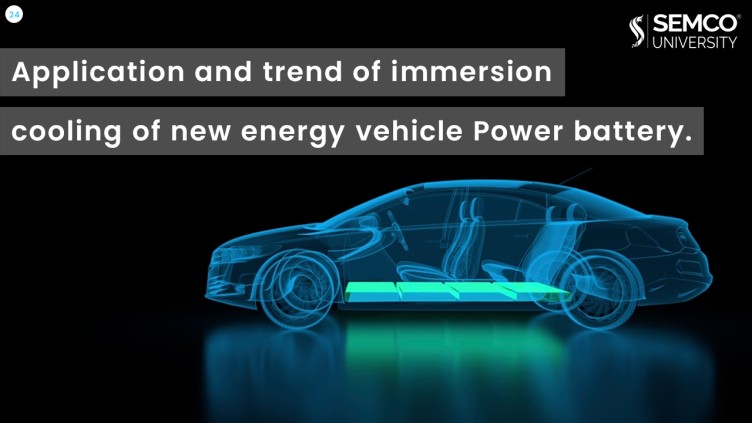Recently, major OEMs are promoting super-fast charging technology, Promoting 0-80% SOC takes 15 minutes or 20 minutes, so that for some large-capacity batteries, the charging rate reaches more than 4C. The battery produces a lot of heat, and the traditional liquid cold plate makes been difficult to digest this heat-producing, and the battery temperature is easy to soar above 60 °C. Second, due to the current inconsistency of battery technology and aging lithium precipitation, fires frequently occur. These two requirements have spawned a new battery thermal management cooling method, of which immersion cooling is one of the directions currently being studied.

- Which OEMs or component factories are studying immersion cooling?
Because of the bottleneck of liquid cooling, and the need to inhibit thermal runaway, like GEELY, Great Wall India R & D Pvt Ltd, BYD has taken the lead in researching immersion cooling, although BYD is currently promoting refrigerant direct cooling, but BYD’s vision is still relatively far, and the feasibility of planning the application of immersion cooling in the next generation of models has been studied.
Tier 3 component suppliers such as AVL, @Richardo, Castrol – Wakefield Canada Inc, Valeo, MAHLE and others have also been researched and equipped with some naked cars for verification.
The domestic state-owned main engine factories are relatively conservative and still adhere to the liquid cooling method, which is destined to be slower than Geely, BYD and other private OEMs.
- What is immersion cooling?

The solution is to use dielectric immersion cooling, whereby the battery is in direct contact with the electrically insulating working fluid. The advantage of this method is that extremely high heat transfer rates can be achieved through direct contact between the cell and the immersed fluid, especially when using two-phase fluid systems. Here, the latent heat of vaporization associated with liquid-gas transition enhances convective heat transfer, with effects such as nuclear boiling that increase the amount of turbulent mixture. In addition, many immersion liquids can be used as extinguishing agents, reducing the risk and effects of thermal runaway. However, to date, immersion cooling systems have not been implemented on a large scale due to challenges such as fluid costs, uncertainty about system life benefits, and integrated weight losses.
Industrial applications for electric vehicles are already emerging, including Kreisel with Shell thermal fluids, XING Mobility with NOVEC fluids using 3M and Rimac Automobili with Galden Studios fluids from Solvay.
This immersion cooling medium is available in single-phase and two-phase.
- Discussion on the coupling relationship between immersion cooling, heat generation and fluid flow

Because immersion cooling is divided into single-phase and two-phase immersion fluids, the figure below shows key metrics such as thermal conductivity, specific heat capacity, and viscosity, as well as their coupling properties to battery performance. Reading this diagram helps everyone understand why immersion cooling is so promising.
- Why can immersion cooling cool the battery?

Think about it, the liquid cold plate is a surface of the contact cell, the cell is composed of multiple layers of materials (positive electrode, negative electrode, separator and electrolyte), there is resistance in the layer, there is contact resistance between the layers, these components of the internal resistance of the battery, the inconsistency between the layers, will lead to the inconsistency of the passing current and SOC of each layer, resulting in cell aging and life decline, which is an important reason. Liquid cooling has limited heat exchange and limited contact area, while immersion cooling is direct contact with the cell, which can greatly ensure temperature uniformity.
- Immersion cooling scheme

As one of the emerging cooling technologies, direct liquid cooling, also known as immersion cooling, is a system in which the battery is immersed in a non-conductive dielectric body, thus in direct contact with the battery. Candidate dielectric currents include: hydrocarbon oils, silicone fluids, and hydrocarbons. This unique cooling method brings several advantages. First, immersion cooling has the potential to provide the best battery pack and cell temperature uniformity across all cooling methods. This is because all battery surfaces are in liquid, providing a uniform, high-capacity heat transfer path for heat dissipation. This direct contact with the battery surface further reduces the thermal contact resistance in indirect cooling systems. Immersion cooling simplifies system design and reduces system complexity. In addition, thermal runaway suppression is often observed in immersion cooling systems, as some dielectric currents are also flame retardants, thereby improving the safety of the battery pack. Depending on the degree of immersion, flow type, and fluid operating state, there are different implementations of immersion cooling:
- Challenges and disadvantages of immersion cooling
Additional complexity/cost of condensing evaporative steam, potentially higher pumping losses in high viscosity fluids, high fluid costs, material compatibility issues, and increased fluid weight.
The challenge is that the McLaren Automotive Ltd sports car speed tail is the world’s first electric high-end sports car with immersion battery technology, and Tesla has also issued some patents for immersion cooling, which can be imagined serving more batteries in the future.
About Semco – Semco University is an educational website that is catering to the needs of students and researchers. Offering information on Lithium-ion batteries. The resources and content are compiled from various sources including manufacturers, test labs, crowdsourcing, etc. Our motto is to provide a viable resource for companies, students, and enthusiasts interested in participating in the Li-ion Battery industry. Our initiative is to make people aware of the benefits, and opportunities of the revolutionary Lithium Batteries for multiple applications.
For More Updates Follow Us
WhatsApp – Facebook – Instagram – Twitter – LinkedIn – YouTube

